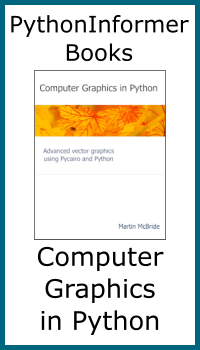Complex paths in generativepy
Categories: generativepy generativepy tutorial

This tutorial shows how to complex paths in generativepy. It follows on from the composite path tutorial.
A complex path is a single path that either:
- Encloses more than one area.
- Contains more than one subpath.
- Or both.
The main difference between a complex path and multiple simple paths is that the complex path is treated as one path when it is filled. This means that, depending on the fill rule selected, various parts of the shape will be filled or unfilled.
Complex polygons
A complex polygon can enclose more than one area, if it is self-intersecting. A well known example is a star-polygon:
from generativepy.drawing import make_image, setup, EVEN_ODD
from generativepy.color import Color
from generativepy.geometry import Polygon
import math
def draw(ctx, pixel_width, pixel_height, frame_no, frame_count):
setup(ctx, pixel_width, pixel_width, background=Color(0.8))
black = Color(0)
red = Color('red')
Polygon(ctx).of_points([(150, 50),
(100, 250),
(250, 150),
(50, 150),
(200, 250),
]).fill(red).stroke(black, 5)
Polygon(ctx).of_points([(450, 50),
(400, 250),
(550, 150),
(350, 150),
(500, 250),
]).fill(red, fill_rule=EVEN_ODD).stroke(black, 5)
make_image("complex-polygon.png", draw, 700, 300)
This code is available on github in tutorial/shapes/complex-polygon.py.
Here is the resulting image:

The code simply draws two polygons, each with 5 points. Due to the order the points are defined in the of_points list, the shape is drawn as a star shape rather than a simple convex pentagon.
In the first case we use the WINDING fill rule (the default) which causes the whole shape to be filled.
In the second case we specify the EVEN_ODD fill rule, which causes the central region of the star shape to be unfilled.
Multiple subpaths
This code draws two rectangles, however it creates them as two separate subpaths within the same path:
from generativepy.drawing import make_image, setup, EVEN_ODD
from generativepy.color import Color
from generativepy.geometry import Line, Rectangle
def draw(ctx, pixel_width, pixel_height, frame_no, frame_count):
setup(ctx, pixel_width, pixel_width, background=Color(0.8))
black = Color(0)
Rectangle(ctx).of_corner_size((50, 50), 350, 250).add()
Rectangle(ctx).of_corner_size((100, 100), 250, 150).as_sub_path()\
.fill(Color('red'), fill_rule=EVEN_ODD)\
.stroke(Color('blue'), 5)
make_image("complex-subpaths.png", draw, 500, 400)
This code is available on github in tutorial/shapes/complex-subpaths.py.
Here is the resulting image:

We create the first Rectangle object, but instead of filling or stroking it, we use add() to add it to the current path (similar to creating a composite path).
For the second Rectangle, we call as_sub_path() to add the item as a subpath within the existing path.
When we fill and stroke the item, both rectangles will be drawn because they are both part of the path. Due to the EVEN_ODD fill rule, the inner rectangle is unfilled.
Related articles
- Polygons in generativepy
- Regular polygons in generativepy
- Circles and ellipses in generativepy
- Bezier curves in generativepy
- Fill and stroke in generativepy
- Stroke styles in generativepy
- Fill styles in generativepy
- Text in generativepy
- Text offset in generativepy
- Text metrics in generativepy
- Composite paths in generativepy
- Images in generativepy
- Geometric markers in generativepy
- Path objects in generativepy
- Turtles in generativepy
Join the GraphicMaths/PythonInformer Newsletter
Sign up using this form to receive an email when new content is added to the graphpicmaths or pythoninformer websites:
Popular tags
2d arrays abstract data type and angle animation arc array arrays bar chart bar style behavioural pattern bezier curve built-in function callable object chain circle classes close closure cmyk colour combinations comparison operator context context manager conversion count creational pattern data science data types decorator design pattern device space dictionary drawing duck typing efficiency ellipse else encryption enumerate fill filter for loop formula function function composition function plot functools game development generativepy tutorial generator geometry gif global variable greyscale higher order function hsl html image image processing imagesurface immutable object in operator index inner function input installing integer iter iterable iterator itertools join l system lambda function latex len lerp line line plot line style linear gradient linspace list list comprehension logical operator lru_cache magic method mandelbrot mandelbrot set map marker style matplotlib monad mutability named parameter numeric python numpy object open operator optimisation optional parameter or pandas path pattern permutations pie chart pil pillow polygon pong positional parameter print product programming paradigms programming techniques pure function python standard library range recipes rectangle recursion regular polygon repeat rgb rotation roundrect scaling scatter plot scipy sector segment sequence setup shape singleton slicing sound spirograph sprite square str stream string stroke structural pattern symmetric encryption template tex text tinkerbell fractal transform translation transparency triangle truthy value tuple turtle unpacking user space vectorisation webserver website while loop zip zip_longest
